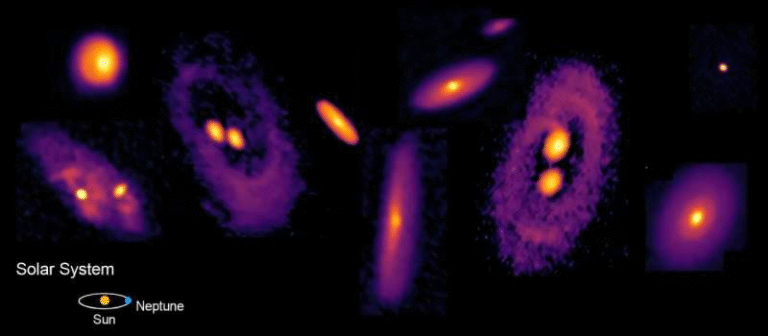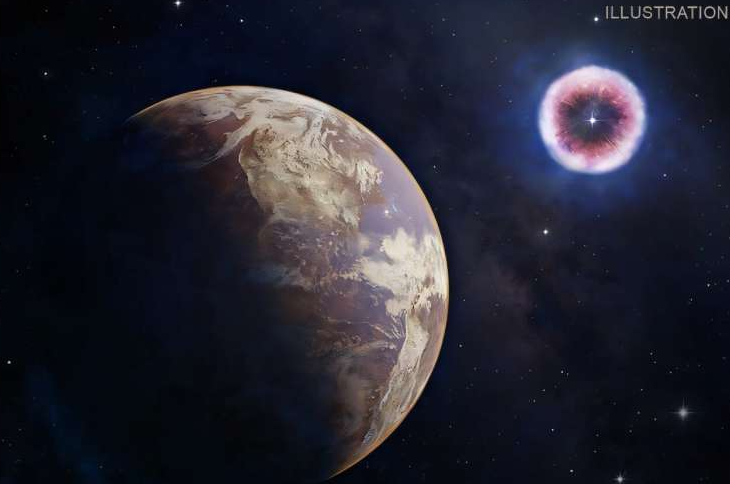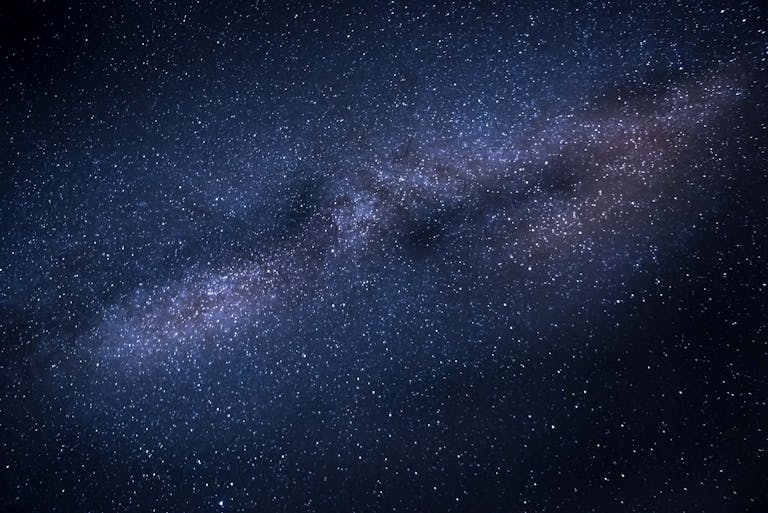JWST Unveils a Large Debris Disk Around the Young M Dwarf Star TWA 20

Astronomers have once again pushed the boundaries of what the James Webb Space Telescope (JWST) can reveal. A team led by Skyler Palatnick from the University of California, Santa Barbara, has discovered a large debris disk encircling a faint red dwarf star known as TWA 20. The finding was made using JWST’s Near-Infrared Camera (NIRCam) and marks one of the clearest detections of a debris disk around a low-mass M-type star to date.
The discovery was first reported in a paper posted on October 23, 2025, on the arXiv preprint server. The results highlight JWST’s extraordinary sensitivity in detecting faint structures that were previously invisible to telescopes on Earth or even to the Hubble Space Telescope.
A Faint Star With a Hidden Disk
TWA 20 is a small, cool M3-type dwarf star located roughly 261.5 light years (about 80.2 parsecs) from Earth. Belonging to the TW Hydrae Association—a nearby group of young stars—TWA 20 is estimated to be around 10 million years old. Its effective temperature is about 3,560 Kelvin, typical for such cool, low-mass stars.
M dwarfs like TWA 20 are the most common type of stars in the Milky Way, but detecting debris disks around them is notoriously difficult. These disks, composed of leftover dust, rocks, comets, and planetesimals from the planet-formation process, emit faint light that is easily drowned out by the star itself. Until recently, only a handful of debris disks around M dwarfs had ever been resolved in scattered light.
That’s what makes this discovery so important: TWA 20’s disk is only the sixth debris disk around an M dwarf that astronomers have ever imaged directly.
The JWST Observations and Techniques
In June 2024, Palatnick’s team used JWST/NIRCam in coronagraphic mode—a setting designed to block out the central starlight and reveal faint material nearby. They observed TWA 20 in two infrared filters: F200W (2.0 microns) and F444W (4.4 microns).
The data were processed using advanced imaging techniques called Reference Differential Imaging (RDI) and Model-Constrained RDI (MCRDI). These methods help remove instrumental noise and starlight contamination, making it possible to spot the faint scattered light from dust grains around the star.
The resulting image revealed a clearly visible ring-like disk tilted relative to our line of sight. The disk’s structure was confirmed through forward modeling and deconvolution—mathematical procedures that sharpen and interpret telescope images.
What the Observations Revealed
The JWST data show that TWA 20 is surrounded by a broad, bright debris disk with a radius of about 64.7 astronomical units (AU)—roughly twice the size of the orbit of Pluto in our own Solar System. The disk’s inclination is measured at 70.1 degrees, meaning we see it from a moderately edge-on perspective, and its position angle is −132.9 degrees.
The team also measured the disk’s peak surface brightness in the F200W filter to be 0.1 megajanskys per steradian (MJy/sr). Detection was strongest in this shorter-wavelength band (with a signal-to-noise ratio of about 13), while the disk appeared only faintly at 4.4 microns (around 2σ significance).
Interestingly, previous infrared surveys—including those from the Spitzer and WISE missions—had shown no measurable infrared excess from TWA 20. In other words, astronomers did not expect to find any dust around it. The new JWST images completely change that picture, revealing a substantial disk that had gone unnoticed until now.
No Companion Found
The researchers also looked for possible planetary or substellar companions that might be sculpting or influencing the disk’s shape. None were detected.
Their analysis indicates that any Jupiter-mass planet or larger object would have been visible in JWST’s coronagraphic data at separations wider than 48 AU. Since no such object was found, it’s likely that no massive companion exists within that range.
How It Compares to Other M Dwarf Disks
Among the small group of known M-dwarf debris disks, TWA 20’s stands out. It is the third largest in size and orbits one of the faintest host stars in this category. The others include disks around stars like AU Mic and GJ 581, but those systems either show stronger infrared excesses or orbit brighter M dwarfs.
TWA 20’s disk is therefore exceptional—large, bright in scattered light, and yet invisible in thermal infrared emission. That combination makes it an ideal test case for studying dust scattering properties and grain compositions in low-temperature stellar environments.
Modeling the Disk and Its Dust
To better understand what they were seeing, the team constructed forward models of the disk. These computer simulations reproduce how light scatters off dust grains, taking into account the star’s light, JWST’s optics, and potential dust-grain properties. The models were run through a pipeline that convolved them with JWST’s point-spread function (PSF) and compared them with the observed images to minimize differences.
The best-fit models confirmed the disk’s geometry and brightness pattern. They also showed that the disk’s light is consistent with backward-scattering dust, though the far side of the disk is partially hidden by JWST’s coronagraph mask.
The researchers ran additional radiative-transfer simulations using the MCFOST code, assuming the dust is made mostly of astrosilicates (a common model for interstellar dust). They estimated the fractional luminosity (Ld/L★) of the disk, though the paper cautions that this value is uncertain because the disk was detected in only one strong band.
Why Debris Disks Matter
Debris disks are more than just pretty rings of dust—they are archaeological records of planetary formation. These disks are what remain after the gas in a young planetary system dissipates, leaving behind planetesimals that continue to collide and grind down into dust.
Studying them reveals how planets interact with leftover material, how dust composition varies with stellar type, and how planetary architectures evolve over millions of years.
For M dwarfs, this is especially interesting. They make up about 70 percent of all stars in our galaxy, yet their debris disks are incredibly rare. That rarity might be due to weaker radiation pressure, smaller disk masses, or slower dust clearing rates. Every new detection—like the one around TWA 20—adds crucial data to this puzzle.
JWST’s Expanding Role in Disk Science
The discovery of TWA 20’s debris disk highlights JWST’s remarkable capabilities. With its high-contrast coronagraphs, infrared sensitivity, and stability in space, JWST can detect faint disks that were previously beyond reach.
This detection was made as part of the GO 4050 survey, a broader program using JWST to image faint debris disks and planetary environments. The success with TWA 20 shows that JWST can now systematically study low-luminosity stars, opening a new window on planetary debris around the smallest suns.
What Comes Next
Future observations may target TWA 20 with ALMA (Atacama Large Millimeter/submillimeter Array) to search for cold dust or millimeter-sized grains that JWST cannot see. If detected, that would allow astronomers to estimate the disk’s total dust mass and check for structures like rings, gaps, or asymmetries that could hint at hidden planets.
Further JWST campaigns will likely apply similar techniques to other M-type stars in the TW Hydrae Association and nearby young clusters. Each new system observed will help refine our understanding of how planet formation proceeds around small, dim stars—and whether systems like our own Solar System are the exception or the rule.
The Bigger Picture
TWA 20’s debris disk is not just another astronomical curiosity—it’s a demonstration of how much more we can now see. For decades, astronomers suspected that many low-mass stars might still host faint disks, but technology limited what could be observed. JWST is now confirming that assumption.
As more of these disks are discovered, we’ll gain insights into how dust evolution, planetary collisions, and stellar winds shape young planetary systems. This will also help refine models of exoplanetary system diversity, since M dwarfs are prime targets for exoplanet searches (including potentially habitable worlds).
The TWA 20 discovery reminds us that even the faintest stars can hide extraordinary secrets—if you have the right tools to look.
Research Paper: Discovery of a Debris Disk Around TWA 20 (Palatnick et al., 2025)





